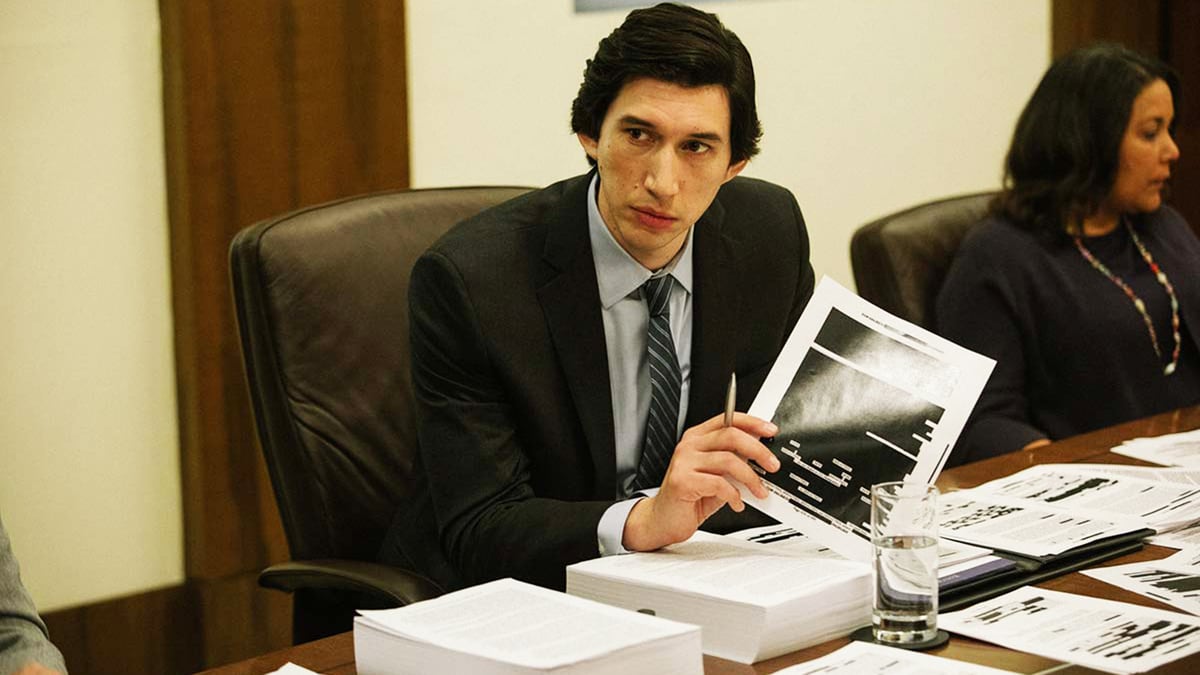The Report, Scott Z. Burns’ film about the CIA “Torture Report,” makes slow-going research and paper pushing compelling, and it does it while maintaining an astonishingly high level of adherence to the literal truth of what happened to the men imprisoned by the American government at “black sites” like Abu Ghraib and Guantanamo, using dialogue usually taken verbatim from the record. Starring Adam Driver as (real person) Daniel Jones, who worked for California Senator Dianne Feinstein to compile an investigation into the CIA’s so-called “enhanced interrogation techniques” post-9/11, The Report offers a vital condemnation not only of the Bush administration’s trigger-happy cronies, but of the Obama administration’s ultimately cynical post-partisan fantasies.
Here’s a bit of living history: Both administrations supported and enabled the CIA in equipping and promoting war criminals, including CIA intelligence officers like Jose Rodriguez and Gina Haspel. The latter is now the director of the agency and was nominated by the Trump administration and confirmed by the majority Republican senate. The film notes that, to date, not one of the CIA’s torturers—their names still have not been released—has been held accountable.
The practice of “enhanced interrogation”—an updated brand of torture—was developed by two barely credentialed psychologists, Bruce Jessen and James Mitchell, who had no experience in interrogation or criminal justice. Mainly, they were overconfident, blood-sucking mediocre white guys looking for vengeance; the CIA, which had already known for decades that torture doesn’t even work (besides being immoral and itself criminal) welcomed the psychologists’ unscientific methods as long as the government’s legal team could spin a defense for them. In the film, actor Pun Bandhu plays John Yoo, the UC Berkeley law professor who, as the Deputy Assistant U.S. Attorney General under George Bush, authored the legal memos that provided that defense and became known as the “Torture Memos.” Fictional Yoo provides the exact justification the real Yoo came up with in the memos: As long as there is no organ failure or death, anything goes, from “gouging eyes” to “pouring acid” on a prisoner’s body.
As Adam Driver’s Daniel Jones indignantly yells in explanation to Feinstein (played by a rigid yet convincing Annette Bening), the CIA’s torture of prisoners—some of whom the FBI, not the CIA, had already gathered enough intel on to prosecute—ensured that no one actually responsible for 9/11 could ever be brought to trial. And on top of that, torture didn’t even work, contrary to the narrative of the Oscar-nominated Bin Laden assassination film Zero Dark Thirty. Despite Jones’ and his team’s painstaking research into emails, memos, and even an internal CIA report that confirms the agency’s own incompetence and corruption, no one seems to care much within the Obama administration, including the president himself—there’s a re-election to be secured and drone strikes to carry out under the CIA’s supervision.
Burns, who also penned Steven Soderbergh’s The Laundromat, originally planned to write and direct a dark comedy film that focused on Jessen and Mitchell. The Laundromat, which Soderbergh admits drew from the narrative style of Adam McKay’s The Big Short, didn’t work precisely because of its overwrought machinations and confused tone (but not, it’s important to point out, because of its comedy). I’m glad Burns opted to take on this story from Jones’ perspective rather than again borrowing from McKay’s playbook of unwittingly legitimizing tyrants and liars. It makes for a film that, rather than gawking at the gall of blood-thirsty cynics, soberly examines their horrible methods, revealing powerful alliances that span not only the halls of power but reach across the aisle as well. The Report—unlike McKay’s dramedies and the practice of torture—is effective, emphasizing humanity as it exposes evil.
Jones is a regular guy who, not unlike Jessen and Mitchell, wants to beat the bad guys. At the start of the film, he meets with Obama’s chief of staff Denis McDonough, who encourages him to get experience in the FBI or on the Hill before trying to get a job with the executive branch. Jones, a bit of a boy scout, eventually finds himself under the direction of Feinstein, whom we later learn has been charged with creating the report only because Obama refuses to task his own branch with the investigation, not wanting to ruin his chances at post-partisan governmental bliss. Over the course of the investigation, Jones develops much of the integrity that evades Obama and his people. Jones—along with a team that the film compresses to six and then three people, but was actually around 20—refuses to turn away from the CIA’s abuses. He fights to have the truth revealed without compromise, which takes the form of gratuitous redactions by the CIA which are sanctioned by Obama via McDonough.
The film ends up emphasizing the limits of Jones’ boy scout behavior, even though it is in service of a righteous cause. Jones meets with a New York Times National Security reporter and considers pulling an Edward Snowden by leaking the full 6,000-page report to the press. Feinstein has already told Jones that she believes Snowden is a traitor—whistleblowers don’t figure into her ideas of justice. Jones is not so sure, and during their meeting, the Times reporter reveals the extent of Obama’s complicity in suppressing the investigation. This information isn’t enough to sway Jones—he ultimately believes he has to take the legal, governmental recourse and doesn’t leak the document. A 582-page summary is released by Congress instead (a recent New York Times story revealed how close even the summary was to being suppressed). None of the real names of those directly accountable are in it, and no one—much like with Obama’s big bank bailout—goes to jail.
Ultimately, liberal ideology—a belief in incremental reform and justice through institutions rather than people—convinces Jones that he shouldn’t blow the whistle. But, to this day, Jones is enraged at the continued lack of accountability in the wake of the report. The summary was released to the public but what resulted was mostly strategically crafted speeches by statesmen like the late Republican senator John McCain and handwringing by concerned citizens; Obama, for his part, admitted, in an absurd turn of phrase, that “we tortured some folks.” CIA agents both complicit and directly involved in torturing detainees were not simply given a pass but promoted within the agency.
The liberalism of Obama’s government and Feinstein’s office did not rock the boat by design. If you watch closely, you’ll see that The Report is not a triumphant film, which is exactly why it has fallen under the radar. The movie not only testifies to the importance of exposing ugly truths, but suggests that self-sacrifice and rebellion may be required for justice to ever be served. Obama, who recently cautioned millennials against leftist revolution, is still preaching his credo of rule-following moderation. If he had gotten his way before, most media outlets would still be reporting that our government had delivered us to safety by way of torture. We would do well to learn from the former president’s example by rejecting it.

